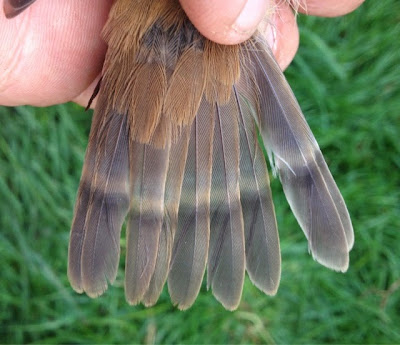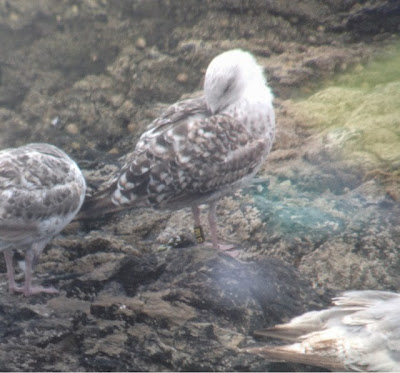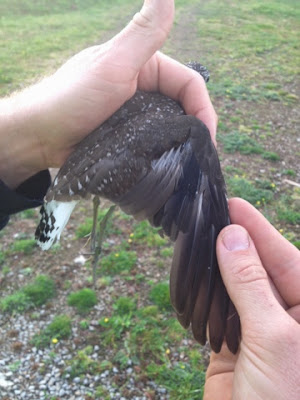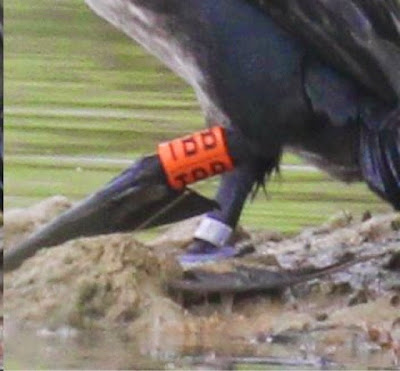...and this time it was an 'at sea' record of one of our Kittiwakes; the first sighting of one of our birds away from our study sites. This excellent record came from group member Tony Blunden on a pelagic trip out of Penzance. Having photographed a bird off Longstones Lighthouse he thought might be ringed, zooming in produced a rather hazy image of one of our rings.
Now so far we've only ringed Kittiwakes with rings beginning A, C and P and those beginning P were ringed as chicks in 2012 or 2013, so that rules them out. So the ring must start C, which narrows it down to a small set of options. Most of these have horizontal bars or curly bits or such like, so the only real possibilities are CL and CT. Even just typing them here, you can see that the vertical bar of the two letters sits either close to or apart from the curl of the C. So with a judicious bit of photoshop-ery with similar unused rings, we're pretty sure this must be CT.
Well I think it's convincing... CT was ringed as a breeding adult at Trewavas Head in July 2013, 29km from where Tony was lucky enough to catch it in flight
27 July 2014
25 July 2014
End of the first-half for Barn Owls
Yesterday saw us ringing the last of our first brood Barn Owls and in summary, it's been quite a successful year. Our last box was one that has never been very successful, with a failure and a non-breeding pair over the last couple of years. But this year they started well, with six eggs, and our visit yesterday found three good-sized chicks.
Looking back, our first broods have produced at least 76 chicks, though a few of the smaller chicks were unlikely to survive. From these first broods, we ringed 63 chicks, which compares pretty well to last year, when we ringed just 19 chicks!
After such a good year we'll no doubt have a few second broods (watch this space), but in the meantime, we can compare this season with the last three...
So all in all a pretty good year, with good clutch and brood sizes and, as the project expands, more chicks ringed. We're already seeing some interesting recaptures, with birds moving around between sites and dispersing quite widely a couple of months after fledging.
Last night also saw an under-performing Storm Petrel session. It was a bit too windy (still nothing by Lizard standards), but the catch of just 25 was a lot less than expected. We did catch one bird that wasn't ours though, so it'll be interesting to see where that's from. What was slightly odd though was that a lot of these birds were already in primary moult, which seems a bit early...
Looking back, our first broods have produced at least 76 chicks, though a few of the smaller chicks were unlikely to survive. From these first broods, we ringed 63 chicks, which compares pretty well to last year, when we ringed just 19 chicks!
 |
| One of the final first-brood chicks ringed, with proud 'parent' |
 |
| ...and back in their box |
| 2011 | 2012 | 2013 | 2014 | |
| Sites visited | 32 | 34 | 32 | 42 |
| Unoccupied | 2 (6%) | 7 (21%) | 12 (38%) | 11 (26%) |
| Occupied but no breeding | 13 (41%) | 2 (6%) | 7 (22%) | 7 (17%) |
| Average clutch size (where observed) | 4.8 | 4.1 | 3.6 | 4.6 |
| Average brood size (where observed) | 3.1 | 3.1 | 2.4 | 3.6 |
| Number of chicks ringed | 33 | 46 | 19 | 63 |
So all in all a pretty good year, with good clutch and brood sizes and, as the project expands, more chicks ringed. We're already seeing some interesting recaptures, with birds moving around between sites and dispersing quite widely a couple of months after fledging.
Last night also saw an under-performing Storm Petrel session. It was a bit too windy (still nothing by Lizard standards), but the catch of just 25 was a lot less than expected. We did catch one bird that wasn't ours though, so it'll be interesting to see where that's from. What was slightly odd though was that a lot of these birds were already in primary moult, which seems a bit early...
20 July 2014
Fault bars and a mystery feather
A good-sized team congregated this morning to run Visit 8 of the CES at Gunwalloe, in perfect conditions. A few hundred Swallows coming out of roost near the nets gave us a few stragglers (including an adult we'd ringed at the roost last week), but the majority of the catch was, predictably, Reed Warblers. The final total of 55 birds caught was close to the visit average of 60 birds, including the welcome return of a few Sedge Warblers, the less welcome return of reedbed Blue Tits and a lone juvenile Cetti's Warbler.
Symptomatic of a spell of poor weather a few weeks ago, we caught two birds both showing really obvious 'fault bars' in the tail. These occur when a period of reduced food supply in the nest means that growing feathers are lacking substance, so show up as weak bars along the tail: akin to tree rings in fact. The fact these bars are all the same distance from the tail tip indicates that these tail feathers were all grown all at the same time (ie in the nest), so is a very good indication these birds are juveniles.
These fault bars are obviously also weak points in the feather and in this second example you can guess that the bird will be left with a rather stubby tail in the not-too-distant future... Not a problem if you're a local resident, but rather more of a problem for a long-distance migrant.
Symptomatic of a spell of poor weather a few weeks ago, we caught two birds both showing really obvious 'fault bars' in the tail. These occur when a period of reduced food supply in the nest means that growing feathers are lacking substance, so show up as weak bars along the tail: akin to tree rings in fact. The fact these bars are all the same distance from the tail tip indicates that these tail feathers were all grown all at the same time (ie in the nest), so is a very good indication these birds are juveniles.
 |
| Sedge Warbler fault bar |
18 July 2014
First Cormorant sighting
After a couple of years ringing, and colour ringing, Cormorants on Mullion Island we've finally had our first sighting! So a big thanks to Mike Morse who saw TBB at West Bexington, Dorset, on Wednesday and sent us the following photos.
In other news, a few extra Barn Owls ringed yesterday brings our total to 69 for the year, so fingers crossed that our last site to visit next week will take us over the 70-mark, and who could resist adding a video of the release of some roosted Swallows from our first catch of the year at Gunwalloe...
TBB was one of 18 birds ringed on the Island on 17th May (see blog post here), so made a pretty quick movement east: West Bexington is just short of 200km from Mullion Island.
The only previous recovery we've had of one of our birds was at a fish farm in Ponsanooth in October last year. It got tangled in netting trying to steal fish, but was released OK.
 |
| Just one more photo of TBB |
14 July 2014
Gulls on the move again
It's been too windy again this weekend to get any nets up, but it's been way more productive to get a 'scope out and look seaward at gulls. Numbers of Great Black-backs are building up again at Lizard Point and we're regularly getting birds from Looe Island and further afield now. We've even had a bizarre run of close neighbours, with colour rings LAN1, LAN3 and LAN7 all being seen over 10th to 12th July; all ringed as chicks on Looe Island on 25th June 2011.
Best record of the week though has been Herring Gull White 7FS7, seen on 12th July. We don't see many colour-ringed Herring Gulls at the point, and this bird had been ringed as a chick on Lihou Island, Guernsey, in June 2013. It has since spent most of its time in France, seen at Treffieux Landfill several times in January 2014.
We've also heard of some other movements of gulls we've blogged about before. Black 96N (ringed in Normandy, France in June 2013) was seen at Lizard Point back in the spring (blogged here) and was also seen on Looe Island six days later. Just recently it popped up in northern France, seen at Port-en-Bessin-Huppain on 28th June.
 |
| Black 51M at Lizard Point today - another Normandy bird |
We've also heard of some other movements of gulls we've blogged about before. Black 96N (ringed in Normandy, France in June 2013) was seen at Lizard Point back in the spring (blogged here) and was also seen on Looe Island six days later. Just recently it popped up in northern France, seen at Port-en-Bessin-Huppain on 28th June.
 |
| Black 96N at Lizard Point in the spring |
8 July 2014
Swallow roost bonus
Having seen how much the reed had grown up at our sewage works site at Gwennap (check out the original reedbed in this blog post), last night we opted to see if any Swallows were roosting there. Bit of a long shot, but if you don't go and check you'll never know.
It didn't look too good as there weren't many birds around anyway, but we stuck up a few nets and hoped. We even added a speculative net alongside one of the settling tanks just in case one of the two regular Green Sandpipers there dropped in. So to cut a long story short, the roost only produced six Swallows and a Chiffchaff, but the extra net chipped in with three more Swallows that got the 'balancing-on-the-top-shelf-for-fun' game a bit wrong and also the hoped for Green Sand - the first ever caught by the group.
This was an adult in active wing moult, and apparently adults birds begin their complete moult on the breeding grounds and slowly moult through migration, finishing on their wintering grounds. Some will also suspend moult part-way through migration, continuing it later in the autumn. As in many waders, it is usually the female that departs first, leaving the male to raise the young which will then start to come through the UK later this month. Either way, a very smart bird indeed!
It didn't look too good as there weren't many birds around anyway, but we stuck up a few nets and hoped. We even added a speculative net alongside one of the settling tanks just in case one of the two regular Green Sandpipers there dropped in. So to cut a long story short, the roost only produced six Swallows and a Chiffchaff, but the extra net chipped in with three more Swallows that got the 'balancing-on-the-top-shelf-for-fun' game a bit wrong and also the hoped for Green Sand - the first ever caught by the group.
 |
| Our bird wasn't too far into the moult of its primaries and hadn't started on the secondaries yet. |
Subscribe to:
Posts (Atom)








